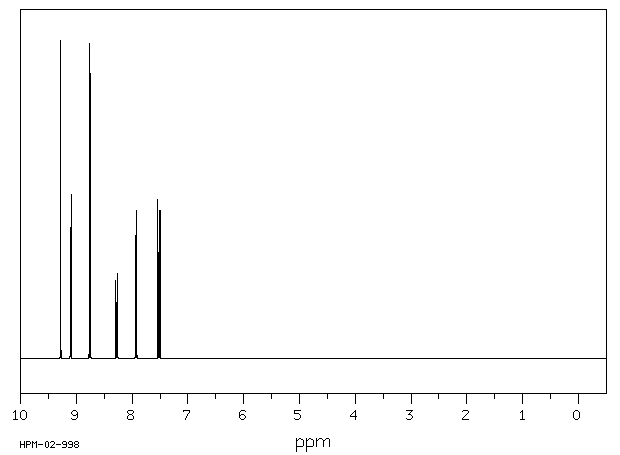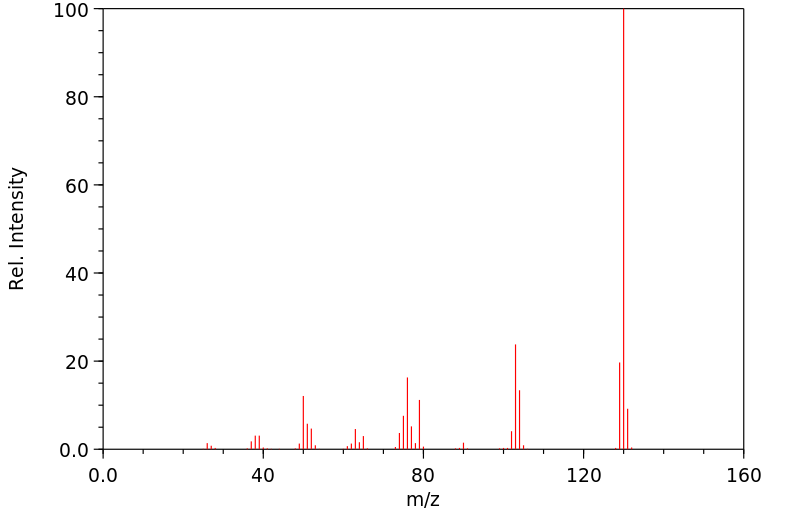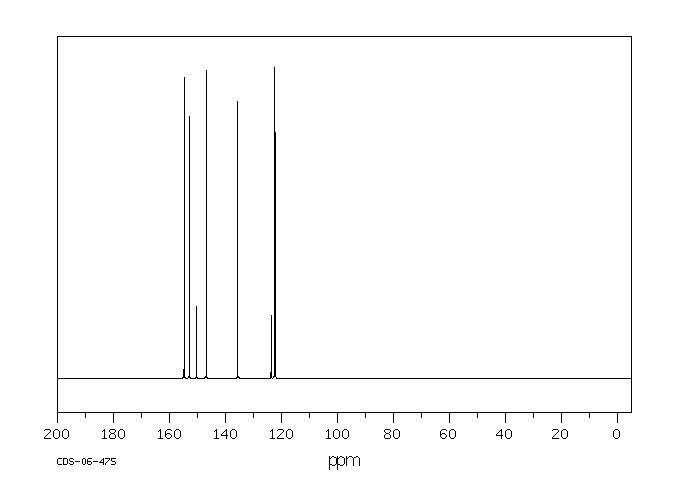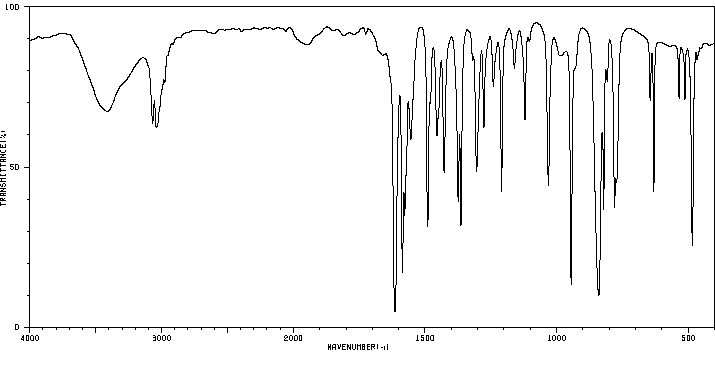1,6-二氮萘 | 253-72-5
中文名称
1,6-二氮萘
中文别名
1,5-二氮萘;[1,6]萘;1,6-萘啶;1,6-二氮杂萘;【口+奈】啶
英文名称
1,6-naphthyridine
英文别名
pyrido[4,3-b]-pyridine
CAS
253-72-5
化学式
C8H6N2
mdl
MFCD00059750
分子量
130.149
InChiKey
VSOSXKMEQPYESP-UHFFFAOYSA-N
BEILSTEIN
——
EINECS
——
-
物化性质
-
计算性质
-
ADMET
-
安全信息
-
SDS
-
制备方法与用途
-
上下游信息
-
文献信息
-
表征谱图
-
同类化合物
-
相关功能分类
-
相关结构分类
物化性质
-
熔点:231-233°C
-
沸点:267.3±13.0 °C(Predicted)
-
密度:1.183±0.06 g/cm3(Predicted)
-
闪点:35 °C
计算性质
-
辛醇/水分配系数(LogP):1.1
-
重原子数:10
-
可旋转键数:0
-
环数:2.0
-
sp3杂化的碳原子比例:0.0
-
拓扑面积:25.8
-
氢给体数:0
-
氢受体数:2
安全信息
-
危险等级:IRRITANT
-
危险品标志:Xi
-
安全说明:S26,S39
-
危险类别码:R41
-
海关编码:2933990090
-
危险标志:GHS05,GHS07
-
危险性描述:H302,H318
-
危险性防范说明:P280,P305 + P351 + P338
-
储存条件:室温且干燥环境中使用。
SDS
1,6-Naphthyridine Revision number: 5
SAFETY DATA SHEET
Section 1. IDENTIFICATION
Product name: 1,6-Naphthyridine
Revision number: 5
Section 2. HAZARDS IDENTIFICATION
GHS classification
PHYSICAL HAZARDS Not classified
Not classified
HEALTH HAZARDS
ENVIRONMENTAL HAZARDS Not classified
GHS label elements, including precautionary statements
Pictograms or hazard symbols None
No signal word
Signal word
Hazard statements None
None
Precautionary statements:
Section 3. COMPOSITION/INFORMATION ON INGREDIENTS
Substance/mixture: Substance
Components: 1,6-Naphthyridine
Percent: ....
CAS Number: 253-72-5
Synonyms: 1,6-Diazanaphthalene , Pyrido[4,3-b]pyridine
Chemical Formula: C8H6N2
Section 4. FIRST AID MEASURES
Inhalation: Remove victim to fresh air and keep at rest in a position comfortable for breathing.
Get medical advice/attention if you feel unwell.
Skin contact: Remove/Take off immediately all contaminated clothing. Rinse skin with
water/shower. If skin irritation or rash occurs: Get medical advice/attention.
Eye contact: Rinse cautiously with water for several minutes. Remove contact lenses, if present
and easy to do. Continue rinsing. If eye irritation persists: Get medical
advice/attention.
Ingestion: Get medical advice/attention if you feel unwell. Rinse mouth.
Protection of first-aiders: A rescuer should wear personal protective equipment, such as rubber gloves and air-
tight goggles.
Section 5. FIRE-FIGHTING MEASURES
Suitable extinguishing Dry chemical, foam, water spray, carbon dioxide.
media:
Specific hazards arising Take care as it may decompose upon combustion or in high temperatures to
from the chemical: generate poisonous fume.
1,6-Naphthyridine
Section 5. FIRE-FIGHTING MEASURES
Precautions for firefighters: Fire-extinguishing work is done from the windward and the suitable fire-extinguishing
method according to the surrounding situation is used. Uninvolved persons should
evacuate to a safe place. In case of fire in the surroundings: Remove movable
containers if safe to do so.
Special protective When extinguishing fire, be sure to wear personal protective equipment.
equipment for firefighters:
Section 6. ACCIDENTAL RELEASE MEASURES
Use personal protective equipment. Keep people away from and upwind of spill/leak.
Personal precautions,
protective equipment and Entry to non-involved personnel should be controlled around the leakage area by
emergency procedures: roping off, etc.
Environmental precautions: Prevent product from entering drains.
Methods and materials for Sweep dust to collect it into an airtight container, taking care not to disperse it.
containment and cleaning Adhered or collected material should be promptly disposed of, in accordance with
up: appropriate laws and regulations.
Section 7. HANDLING AND STORAGE
Precautions for safe handling
Handling is performed in a well ventilated place. Wear suitable protective equipment.
Technical measures:
Prevent dispersion of dust. Wash hands and face thoroughly after handling.
Use a local exhaust if dust or aerosol will be generated.
Advice on safe handling: Avoid contact with skin, eyes and clothing.
Conditions for safe storage, including any
incompatibilities
Storage conditions: Keep container tightly closed. Store in a cool and dark place.
Store under inert gas.
Protect from moisture.
Store away from incompatible materials such as oxidizing agents.
Hygroscopic
Packaging material: Comply with laws.
Section 8. EXPOSURE CONTROLS / PERSONAL PROTECTION
Engineering controls: Install a closed system or local exhaust as possible so that workers should not be
exposed directly. Also install safety shower and eye bath.
Personal protective equipment
Respiratory protection: Dust respirator. Follow local and national regulations.
Hand protection: Protective gloves.
Safety glasses. A face-shield, if the situation requires.
Eye protection:
Skin and body protection: Protective clothing. Protective boots, if the situation requires.
Section 9. PHYSICAL AND CHEMICAL PROPERTIES
Physical state (20°C): Solid
Crystal- Powder
Form:
Colour: White - Pale yellow
No data available
Odour:
pH: No data available
Melting point/freezing point:35°C (Freezing point)
Boiling point/range: No data available
No data available
Flash point:
Flammability or explosive
limits:
Lower: No data available
No data available
Upper:
Relative density: No data available
Solubility(ies):
[Water] No data available
1,6-Naphthyridine
Section 9. PHYSICAL AND CHEMICAL PROPERTIES
[Other solvents] No data available
Section 10. STABILITY AND REACTIVITY
Chemical stability: Stable under proper conditions.
Possibility of hazardous No special reactivity has been reported.
reactions:
Incompatible materials: Oxidizing agents
Hazardous decomposition Carbon monoxide, Carbon dioxide, Nitrogen oxides (NOx)
products:
Section 11. TOXICOLOGICAL INFORMATION
Acute Toxicity: No data available
Skin corrosion/irritation: No data available
Serious eye No data available
damage/irritation:
Germ cell mutagenicity: No data available
Carcinogenicity:
IARC = No data available
No data available
NTP =
Reproductive toxicity: No data available
Section 12. ECOLOGICAL INFORMATION
Ecotoxicity:
Fish: No data available
Crustacea: No data available
Algae: No data available
Persistence / degradability: No data available
No data available
Bioaccumulative
potential(BCF):
Mobility in soil
Log Pow: No data available
Soil adsorption (Koc): No data available
Henry's Law No data available
constant(PaM3/mol):
Section 13. DISPOSAL CONSIDERATIONS
Recycle to process, if possible. Consult your local regional authorities. You may be able to dissolve or mix material
with a combustible solvent and burn in a chemical incinerator equipped with an afterburner and scrubber system.
Observe all federal, state and local regulations when disposing of the substance.
Section 14. TRANSPORT INFORMATION
Hazards Class: Does not correspond to the classification standard of the United Nations
UN-No: Not listed
Section 15. REGULATORY INFORMATION
Safe management ordinance of dangerous chemical product (State Council announces on January 26, 2002
and revised on February 16,2011): Safe use and production, the storage of a dangerous chemical, transport,
loading and unloading were prescribed.
1,6-Naphthyridine
SECTION 16 - ADDITIONAL INFORMATION
N/A
SAFETY DATA SHEET
Section 1. IDENTIFICATION
Product name: 1,6-Naphthyridine
Revision number: 5
Section 2. HAZARDS IDENTIFICATION
GHS classification
PHYSICAL HAZARDS Not classified
Not classified
HEALTH HAZARDS
ENVIRONMENTAL HAZARDS Not classified
GHS label elements, including precautionary statements
Pictograms or hazard symbols None
No signal word
Signal word
Hazard statements None
None
Precautionary statements:
Section 3. COMPOSITION/INFORMATION ON INGREDIENTS
Substance/mixture: Substance
Components: 1,6-Naphthyridine
Percent: ....
CAS Number: 253-72-5
Synonyms: 1,6-Diazanaphthalene , Pyrido[4,3-b]pyridine
Chemical Formula: C8H6N2
Section 4. FIRST AID MEASURES
Inhalation: Remove victim to fresh air and keep at rest in a position comfortable for breathing.
Get medical advice/attention if you feel unwell.
Skin contact: Remove/Take off immediately all contaminated clothing. Rinse skin with
water/shower. If skin irritation or rash occurs: Get medical advice/attention.
Eye contact: Rinse cautiously with water for several minutes. Remove contact lenses, if present
and easy to do. Continue rinsing. If eye irritation persists: Get medical
advice/attention.
Ingestion: Get medical advice/attention if you feel unwell. Rinse mouth.
Protection of first-aiders: A rescuer should wear personal protective equipment, such as rubber gloves and air-
tight goggles.
Section 5. FIRE-FIGHTING MEASURES
Suitable extinguishing Dry chemical, foam, water spray, carbon dioxide.
media:
Specific hazards arising Take care as it may decompose upon combustion or in high temperatures to
from the chemical: generate poisonous fume.
1,6-Naphthyridine
Section 5. FIRE-FIGHTING MEASURES
Precautions for firefighters: Fire-extinguishing work is done from the windward and the suitable fire-extinguishing
method according to the surrounding situation is used. Uninvolved persons should
evacuate to a safe place. In case of fire in the surroundings: Remove movable
containers if safe to do so.
Special protective When extinguishing fire, be sure to wear personal protective equipment.
equipment for firefighters:
Section 6. ACCIDENTAL RELEASE MEASURES
Use personal protective equipment. Keep people away from and upwind of spill/leak.
Personal precautions,
protective equipment and Entry to non-involved personnel should be controlled around the leakage area by
emergency procedures: roping off, etc.
Environmental precautions: Prevent product from entering drains.
Methods and materials for Sweep dust to collect it into an airtight container, taking care not to disperse it.
containment and cleaning Adhered or collected material should be promptly disposed of, in accordance with
up: appropriate laws and regulations.
Section 7. HANDLING AND STORAGE
Precautions for safe handling
Handling is performed in a well ventilated place. Wear suitable protective equipment.
Technical measures:
Prevent dispersion of dust. Wash hands and face thoroughly after handling.
Use a local exhaust if dust or aerosol will be generated.
Advice on safe handling: Avoid contact with skin, eyes and clothing.
Conditions for safe storage, including any
incompatibilities
Storage conditions: Keep container tightly closed. Store in a cool and dark place.
Store under inert gas.
Protect from moisture.
Store away from incompatible materials such as oxidizing agents.
Hygroscopic
Packaging material: Comply with laws.
Section 8. EXPOSURE CONTROLS / PERSONAL PROTECTION
Engineering controls: Install a closed system or local exhaust as possible so that workers should not be
exposed directly. Also install safety shower and eye bath.
Personal protective equipment
Respiratory protection: Dust respirator. Follow local and national regulations.
Hand protection: Protective gloves.
Safety glasses. A face-shield, if the situation requires.
Eye protection:
Skin and body protection: Protective clothing. Protective boots, if the situation requires.
Section 9. PHYSICAL AND CHEMICAL PROPERTIES
Physical state (20°C): Solid
Crystal- Powder
Form:
Colour: White - Pale yellow
No data available
Odour:
pH: No data available
Melting point/freezing point:35°C (Freezing point)
Boiling point/range: No data available
No data available
Flash point:
Flammability or explosive
limits:
Lower: No data available
No data available
Upper:
Relative density: No data available
Solubility(ies):
[Water] No data available
1,6-Naphthyridine
Section 9. PHYSICAL AND CHEMICAL PROPERTIES
[Other solvents] No data available
Section 10. STABILITY AND REACTIVITY
Chemical stability: Stable under proper conditions.
Possibility of hazardous No special reactivity has been reported.
reactions:
Incompatible materials: Oxidizing agents
Hazardous decomposition Carbon monoxide, Carbon dioxide, Nitrogen oxides (NOx)
products:
Section 11. TOXICOLOGICAL INFORMATION
Acute Toxicity: No data available
Skin corrosion/irritation: No data available
Serious eye No data available
damage/irritation:
Germ cell mutagenicity: No data available
Carcinogenicity:
IARC = No data available
No data available
NTP =
Reproductive toxicity: No data available
Section 12. ECOLOGICAL INFORMATION
Ecotoxicity:
Fish: No data available
Crustacea: No data available
Algae: No data available
Persistence / degradability: No data available
No data available
Bioaccumulative
potential(BCF):
Mobility in soil
Log Pow: No data available
Soil adsorption (Koc): No data available
Henry's Law No data available
constant(PaM3/mol):
Section 13. DISPOSAL CONSIDERATIONS
Recycle to process, if possible. Consult your local regional authorities. You may be able to dissolve or mix material
with a combustible solvent and burn in a chemical incinerator equipped with an afterburner and scrubber system.
Observe all federal, state and local regulations when disposing of the substance.
Section 14. TRANSPORT INFORMATION
Hazards Class: Does not correspond to the classification standard of the United Nations
UN-No: Not listed
Section 15. REGULATORY INFORMATION
Safe management ordinance of dangerous chemical product (State Council announces on January 26, 2002
and revised on February 16,2011): Safe use and production, the storage of a dangerous chemical, transport,
loading and unloading were prescribed.
1,6-Naphthyridine
SECTION 16 - ADDITIONAL INFORMATION
N/A
制备方法与用途
用途
1,5-二氮萘是一种医药中间体,可通过4-氨基吡啶作为起始物料制备得到,并用于制备CXCR4抑制剂。
制备将浓硫酸(30 mL)缓慢加入20 mL水中,依次加入D22-1(3.76 g, 40.0 mmol)、甘油(12.52 g, 136 mmol)和间硝基苯磺酸钠(19.8 g, 88.0 mmol),加热至130℃,搅拌过夜。随后加入2 N氢氧化钠水溶液调节pH值至10,过滤后用二氯甲烷(2 × 200 mL)萃取两次,合并有机相并减压浓缩。通过硅胶柱层析纯化(石油醚:乙酸乙酯 = 20:1 至 1:1),最终得到黄色固体中间体D22-2即1,5-二氮萘(900 mg,收率69%)。
上下游信息
-
上游原料
中文名称 英文名称 CAS号 化学式 分子量 1,6-萘并吡啶-5(6H)-酮 1,6-naphthyridine-5(6H)-one 23616-31-1 C8H6N2O 146.148 5-氯-[1,6]萘啶 5-chloro-1,6-naphthyridine 23616-32-2 C8H5ClN2 164.594 -
下游产品
中文名称 英文名称 CAS号 化学式 分子量 —— 1,6-naphthyridine-6-oxide 23616-37-7 C8H6N2O 146.148 1,6-萘啶-2(1H)-酮 1,6-naphthyridin-2(1H)-one 23616-29-7 C8H6N2O 146.148 1,6-萘啶-2-胺 1,6-naphthyridin-2-amine 17965-81-0 C8H7N3 145.164 1,6-萘并吡啶-5(6H)-酮 1,6-naphthyridine-5(6H)-one 23616-31-1 C8H6N2O 146.148 8-溴-1,6-萘啶 8-bromo-1,6-naphthyridine 17965-74-1 C8H5BrN2 209.045
反应信息
-
作为反应物:参考文献:名称:抗分枝杆菌 N-(2-Arylethyl)quinolin-3-amines 受海洋海绵衍生生物碱的启发。摘要:对海绵衍生生物碱 3-(苯乙氨基)去甲基(氧基)aaptamine 的简化类似物进行了合成和评价,以开发新型抗分枝杆菌物质。三环苯并[de][1,6]-萘啶骨架的截环有效削弱了天然产物的细胞毒性,所得AC环类似物表现出良好的抗分枝杆菌活性。结构-活性关系 (SAR) 研究、合成和评估一些类似物,证明了 N-(2-芳基乙基)喹啉-3-胺骨架作为抗分枝杆菌先导化合物的有前途支架的特异性和重要性。DOI:10.3390/molecules27248701
-
作为产物:描述:2-溴-3-吡啶甲醛 在 bis-triphenylphosphine-palladium(II) chloride 、 copper(l) iodide 氨 、 三乙胺 作用下, 以 乙醇 、 N,N-二甲基甲酰胺 为溶剂, 反应 3.5h, 生成 1,6-二氮萘参考文献:名称:General Synthetic Method for Naphthyridines and Their N-Oxides Containing Isoquinolinic Nitrogen摘要:通过o-乙炔基吡啶甲醛与氨的反应,合成了含有异喹啉氮的取代萘啶。通过相应的肟,这些吡啶衍生物的N-氧化物也通过基本的环化反应得到合成。DOI:10.1055/s-1999-3379
文献信息
-
SUBSTITUTED ARYL AND HETEROARYL CARBOXYLIC ACID HYDRAZIDES OR SALTS THEREOF AND USE THEREOF TO INCREASE STRESS TOLERANCE IN PLANTS申请人:BAYER CROPSCIENCE AKTIENGESELLSCHAFT公开号:US20180206495A1公开(公告)日:2018-07-26Substituted aryl- and heteroarylcarbonyl hydrazides The invention relates to substituted aryl- and heteroarylcarbonyl hydrazides of the general formula (I) or salts thereof where the radicals of the formula (I) are each as defined in the description for enhancing stress tolerance in plants to abiotic stress, and for enhancing plant growth and/or for increasing plant yield.
-
[EN] HETEROCYCLIC COMPOUNDS AS INHIBITORS OF HPK1<br/>[FR] COMPOSÉS HÉTÉROCYCLIQUES UTILISÉS EN TANT QU'INHIBITEURS DE HPK1申请人:GUANGDONG NEWOPP BIOPHARMACEUTICALS CO LTD公开号:WO2021004547A1公开(公告)日:2021-01-14This disclosure relates to heterocyclics as inhibitors of HPK1, in particular relates to a compound of Formula I or a pharmaceutically acceptable salt thereof, and a pharmaceutical composition comprising said compound that useful for treatment of HPK1 mediated diseases and conditions such as cancer. (I)
-
BIS-QUATERNARY AMMONIUM SALTS AS PAIN MODULATING AGENTS申请人:HOLTMAN Joseph R.公开号:US20110166177A1公开(公告)日:2011-07-07Provided are methods for using bis-quaternary ammonium compounds to treat inflammatory pain, neuropathic pain and nociceptive pain.提供了使用双季铵化合物治疗炎症性疼痛、神经病理性疼痛和伤害性疼痛的方法。
-
[EN] SMALL MOLECULE DCN1 INHIBITORS AND THERAPEUTIC METHODS USING THE SAME<br/>[FR] INHIBITEURS DE DCN1 À PETITES MOLÉCULES ET PROCÉDÉS THÉRAPEUTIQUES LES UTILISANT申请人:UNIV MICHIGAN REGENTS公开号:WO2018183411A1公开(公告)日:2018-10-04Compounds of formula (I) as inhibitors of DCNl and compositions containing the same are disclosed. Methods of using the DCNl inhibitors in the treatment of diseases and conditions wherein inhibition of DCNl provides a benefit, like oxidative stress-related diseases and conditions, neurodegenerative diseases and conditions, metabolic disorders, and muscular nerve degeneration, also are disclosed.
-
[EN] DIHYDROBENZOFURAN AND INDEN ANALOGS AS CARDIAC SARCOMERE INHIBITORS<br/>[FR] ANALOGUES DE DIHYDROBENZOFURANE ET D'INDEN EN TANT QU'INHIBITEURS DE SARCOMES CARDIAQUES申请人:CYTOKINETICS INC公开号:WO2019144041A1公开(公告)日:2019-07-25Provided are compounds of Formula (I), or a pharmaceutically acceptable salt thereof, wherein A, Z, B, R1, R2, R3, G1, G2, and G3 are as defined herein. Also provided is a pharmaceutically acceptable composition comprising a compound of Formula (I), or a pharmaceutically acceptable salt thereof Also provided are methods of using a compound of Formula (I), or a pharmaceutically acceptable salt, thereof for use in methods of treatment heart diseases through cardiac sarcomere inhibtion.提供的是式(I)的化合物,或其药学上可接受的盐,其中A、Z、B、R1、R2、R3、G1、G2和G3如本文所定义。还提供了一种包含式(I)的化合物或其药学上可接受的盐的药学上可接受的组合物。还提供了使用式(I)的化合物或其药学上可接受的盐的方法,用于治疗心脏疾病通过心肌肌节抑制。
表征谱图
-
氢谱1HNMR
-
质谱MS
-
碳谱13CNMR
-
红外IR
-
拉曼Raman
-
峰位数据
-
峰位匹配
-
表征信息
同类化合物
(12羟基吲[2,1-b〕喹唑啉-6(12H)-酮)
黑暗猝灭剂BHQ-3,BHQ-3NHS
鸭嘴花酚碱
鸭嘴花碱酮;(S)-2,3-二氢-3,7-二羟基吡咯并[2,1-b]喹唑啉-9(1H)-酮
鸭嘴花碱酮
鸭嘴花碱盐酸盐
鲁米诺单钠盐
鲁米诺
骆驼蓬碱
颜料蓝64
颜料蓝60
顺式-卤夫酮
顺式-(喹喔啉-2-基)丙烯腈1,4-二氧化物
非奈利酮
青黛酮
雷替曲塞杂质1
阿法替尼杂质J
阿法替尼杂质I
阿法替尼杂质28
阿法替尼杂质18
阿法替尼杂质13
阿法替尼杂质
阿法替尼中间体
阿法替尼
阿法替尼
阿朴藏红
阿巴康唑
阿夫唑嗪杂质A
阿夫唑嗪杂质
阿夫唑嗪EP杂质C
阿夫唑嗪
阿喹司特
阿呋唑嗪杂质
阿呋唑嗪杂质
铜迈星
铁诱导细胞死亡激活剂
钠四丙基硼酸酯
酸性蓝98
酸性红101
酮色林醇
酞联氮基[2,3-b]酞嗪-5,14-二酮,7,12-二氢-
酞嗪-5-羧酸
酞嗪-2-氧化物
酚藏花红
酚嗪
酒石酸溴莫尼定
邻苯二甲酰肼
还原黄6GD
还原蓝6
达尼喹酮










